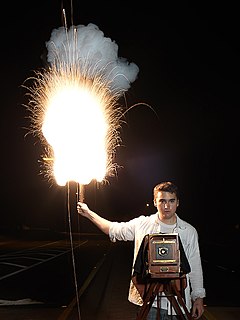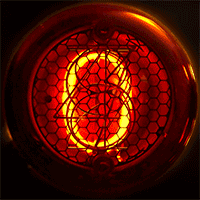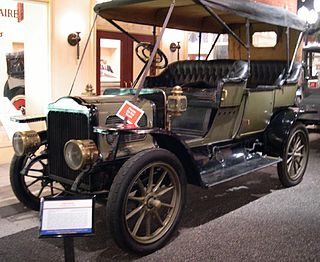 W
WAdobe Authorware was an interpreted, flowchart-based, graphical programming language. Authorware is used for creating interactive programs that can integrate a range of multimedia content, particularly electronic educational technology applications. The flowchart model differentiates Authorware from other authoring tools, such as Adobe Flash and Adobe Director, which rely on a visual stage, time-line and script structure.
 W
WAdobe Shockwave Player is a discontinued freeware software plug-in for viewing multimedia and video games created on the Adobe Shockwave platform in web pages. Content was developed with Adobe Director and published on the Internet. Such content could be viewed in a web browser on any computer with the Shockwave Player plug-in installed. It was first developed by Macromedia and released in 1995; it was later acquired by Adobe Systems in 2005.
 W
WAn amplidyne is an electromechanical amplifier invented prior to World War II by Ernst Alexanderson. It consists of an electric motor driving a DC generator. The signal to be amplified is applied to the generator's field winding, and its output voltage is an amplified copy of the field current. The amplidyne was used in industry in high power servo and control systems, to amplify low power control signals to control powerful electric motors, for example. It is now mostly obsolete.
 W
WApple TV is a digital media player and microconsole developed and sold by Apple Inc. It is a small network appliance and entertainment device that can receive digital data for visual and audio content such as music, video, video games, or the screen display of certain other devices, and play it on a connected television set or other video display.
 W
WButton copy is a type of physical design for road signs in the United States. Round plastic retroreflective buttons made of transparent plastic are placed in rows following the contours of sign legend elements, usually painted white, such as letters, numbers, arrows, and borders. In daylight, the buttons visually blend with the white sign legend elements and so are minimally conspicuous. At night, light from each approaching vehicle's headlamps strikes the retroreflective buttons and is reflected back towards the eyes of the vehicle's driver. Thus the sign is made sufficiently conspicuous and legible for adequately fast and accurate recognition and interpretation by drivers.
 W
WThe Calculagraph is a device which mechanically calculates and prints the elapsed time between two events. Their best known, earliest use was as a means of tracking of table usage in pool halls. Later, until the advent of the digital era, they became the standard way to clock the duration of toll telephone calls.
 W
WA carriage is a private four-wheeled vehicle for people and is most commonly horse-drawn. Second-hand private carriages were common public transport, the equivalent of modern cars used as taxis. Carriage suspensions are by leather strapping and, on those made in recent centuries, steel springs. Two-wheeled carriages are informal and usually owner-driven.
 W
WA catapult is a ballistic device used to launch a projectile a great distance without the aid of gunpowder or other propellants – particularly various types of ancient and medieval siege engines. A catapult uses the sudden release of stored potential energy to propel its payload. Most convert tension or torsion energy that was more slowly and manually built up within the device before release, via springs, bows, twisted rope, elastic, or any of numerous other materials and mechanisms. The counterweight trebuchet is a type of catapult that uses gravity.
 W
WThe cementation process is an obsolete technology for making steel by carburization of iron. Unlike modern steelmaking, it increased the amount of carbon in the iron. It was apparently developed before the 17th century. Derwentcote Steel Furnace, built in 1720, is the earliest surviving example of a cementation furnace. Another example in the UK is the cementation furnace in Doncaster Street, Sheffield.
 W
WDial-up Internet access is a form of Internet access that uses the facilities of the public switched telephone network (PSTN) to establish a connection to an Internet service provider (ISP) by dialing a telephone number on a conventional telephone line. Dial-up connections use modems to decode audio signals into data to send to a router or computer, and to encode signals from the latter two devices to send to another modem.
 W
WThe electric flash-lamp uses electric current to start flash powder burning, to provide a brief sudden burst of bright light. It was principally used for flash photography in the early 20th century but had other uses as well. Previously, photographers' flash powder, introduced in 1887 by Adolf Miethe and Johannes Gaedicke, had to be ignited manually, exposing the user to greater risk.
 W
WThe first-generation iPad is a tablet computer designed and marketed by Apple Inc. as the first device in the iPad lineup of tablet computers. The device features an Apple A4 SoC, a 9.7" touchscreen display, and, on certain variants, the capability of accessing cellular networks. Using the iOS operating system, the iPad can play music, send and receive email and browse the web. Other functions, which include the ability to play games and access references, GPS navigation software and social network services can be enabled by downloading apps.
 W
WThe third-generation iPad is a tablet computer, developed and marketed by Apple Inc. The third device in the iPad line of tablets, it added a Retina Display, the new Apple A5X chip with a quad-core graphics processor, a 5-megapixel camera, HD 1080p video recording, voice dictation, and support for LTE networks in North America. It shipped with iOS 5, which also provides a platform for audio-visual media, including electronic books, periodicals, films, music, computer games, presentations and web browsing.
 W
WThe iPhone is the first smartphone designed and marketed by Apple Inc. After years of rumors and speculation, it was officially announced in January 2007, and was released in the United States in June.
 W
WThe iPhone 3G is a smartphone designed and marketed by Apple Inc.; it is the second generation of iPhone, successor to the original iPhone, and was introduced on June 9, 2008, at the WWDC 2008 at the Moscone Center in San Francisco, United States.
 W
WThe iPhone 3GS is a smartphone that was designed and marketed by Apple Inc. It is the third generation iPhone and the successor to the iPhone 3G. It was unveiled on June 8, 2009 at the WWDC 2009 which took place at the Moscone Center in San Francisco.
 W
WThe iPhone 4 is a smartphone that was designed and marketed by Apple Inc. It is the fourth generation of the iPhone lineup, succeeding the iPhone 3GS and preceding the 4S. Following a number of notable leaks, the iPhone 4 was first unveiled on June 7, 2010, at Apple's Worldwide Developers Conference in San Francisco, and was released on June 24, 2010, in the United States, United Kingdom, France, Germany, and Japan. The iPhone 4 introduced a new hardware design to the iPhone family, which Apple's CEO Steve Jobs touted as the thinnest smartphone in the world at the time; it consisted of a stainless steel frame which doubled as an antenna, with internal components situated between two panels of aluminosilicate glass. The iPhone 4 also introduced Apple's new high-resolution "Retina Display", while maintaining the same physical size and aspect ratio as its precursors. The iPhone 4 also introduced Apple's A4 system-on-chip, along with iOS 4—which notably introduced multitasking functionality and Apple's new FaceTime video chat service. The iPhone 4 was also the first iPhone to include a front-facing camera, and the first to be released in a version for CDMA networks, ending AT&T's period as the exclusive carrier of iPhone products in the United States.
 W
WThe iPhone 5 is a smartphone that was designed and marketed by Apple Inc. It is the 6th generation iPhone, succeeding the iPhone 4S and preceding both the iPhone 5S and 5C. It was formally unveiled as part of a press event on September 12, 2012, and subsequently released on September 21, 2012. The iPhone 5 was the first iPhone to be announced in September, and setting a trend for subsequent iPhone releases, the first iPhone to be completely developed under the guidance of Tim Cook and the last iPhone to be overseen by Steve Jobs. The iPhone 5's design was used three times, first with the iPhone 5 itself in 2012, then with the 5S in 2013, and finally with the first-generation iPhone SE in 2016. It had a 4 inch screen, similar to the iPhone 5C and iPhone 5S, and was released about ten months after Steve Jobs died.
 W
WThe fourth-generation iPod Touch is a multi touch all-purpose pocket computer designed and marketed by Apple Inc. with a touchscreen-based user interface. A successor to the 3rd-generation iPod Touch, it was unveiled at Apple's media event on September 1, 2010, and was released on September 12, 2010. It is compatible with up to iOS 6.1.6, which was released on February 21, 2014.
 W
WKinescope, shortened to kine, also known as telerecording in Britain, is a recording of a television program on motion picture film, directly through a lens focused on the screen of a video monitor. The process was pioneered during the 1940s for the preservation, re-broadcasting and sale of television programmes before the introduction of videotape, which from 1956 eventually superseded the use of kinescopes for all of these purposes. Kinescopes were the only practical way to preserve live television broadcasts prior to videotape.
 W
WThe stencil duplicator or mimeograph machine is a low-cost duplicating machine that works by forcing ink through a stencil onto paper. The mimeograph process should not be confused with the spirit duplicator process.
 W
WA monochrome monitor is a type of CRT computer monitor which was very common in the early days of computing, from the 1960s through the 1980s, before color monitors became popular. They are still widely used in applications such as computerized cash register systems, owing to the age of many registers. Green screen was the common name for a monochrome monitor using a green "P1" phosphor screen; the term is often misused to refer to any block mode display terminal, regardless of color, e.g., IBM 3279, 3290.
 W
WMulti-image is the now largely obsolete practice and business of using 35mm slides (diapositives) projected by single or multiple slide projectors onto one or more screens in synchronization with an audio voice-over or music track. Multi-image productions are also known as multi-image slide presentations, slide shows and diaporamas and are a specific form of multimedia or audio-visual production.
 W
WA Nixie tube, or cold cathode display, is an electronic device used for displaying numerals or other information using glow discharge.
 W
WA pager is a wireless telecommunications device that receives and displays alphanumeric or voice messages. One-way pagers can only receive messages, while response pagers and two-way pagers can also acknowledge, reply to, and originate messages using an internal transmitter.
 W
WPhonograph cylinders are the earliest commercial medium for recording and reproducing sound. Commonly known simply as "records" in their era of greatest popularity, these hollow cylindrical objects have an audio recording engraved on the outside surface, which can be reproduced when they are played on a mechanical cylinder phonograph. In the 1910s, the competing disc record system triumphed in the marketplace to become the dominant commercial audio medium.
 W
WPulse dialing is a signaling technology in telecommunications in which a direct current local loop circuit is interrupted according to a defined coding system for each signal transmitted, usually a digit. This lends the method the often used name loop disconnect dialing. In the most common variant of pulse dialing, decadic dialing, each of the ten Arabic numerals are encoded in a sequence of up to ten pulses. The most common version decodes the digits 1 through 9, as one to nine pulses, respectively, and the digit 0 as ten pulses. Historically, the most common device to produce such pulse trains is the rotary dial of the telephone, lending the technology another name, rotary dialing.
 W
WThe MPU-401, where MPU stands for MIDI Processing Unit, is an important but now obsolete interface for connecting MIDI-equipped electronic music hardware to personal computers. It was designed by Roland Corporation, which also co-authored the MIDI standard.
 W
WA steam car is a car (automobile) propelled by a steam engine. A steam engine is an external combustion engine (ECE) in which the fuel is combusted outside of the engine, unlike an internal combustion engine (ICE) in which fuel is combusted inside the engine. ECEs have a lower thermal efficiency, but carbon monoxide production is more readily regulated.
 W
WA treadwheel crane is a wooden, human powered, hoisting and lowering device. It was primarily used during the Roman period and the Middle Ages in the building of castles and cathedrals. The often heavy charge is lifted as the individual inside the treadwheel crane walks. The rope attached to a pulley is turned onto a spindle by the rotation of the wheel thus allowing the device to hoist or lower the affixed pallet.
 W
WA trebuchet is a type of catapult that uses a long arm to throw a projectile. It was a common powerful siege engine until the advent of gunpowder.
 W
WWindows XP is an operating system produced by Microsoft as part of the Windows NT family of operating systems. It was the successor to both Windows 2000 for professional users and Windows Me for home users. It was released to manufacturing on August 24, 2001, and broadly released for retail sale on October 25, 2001.